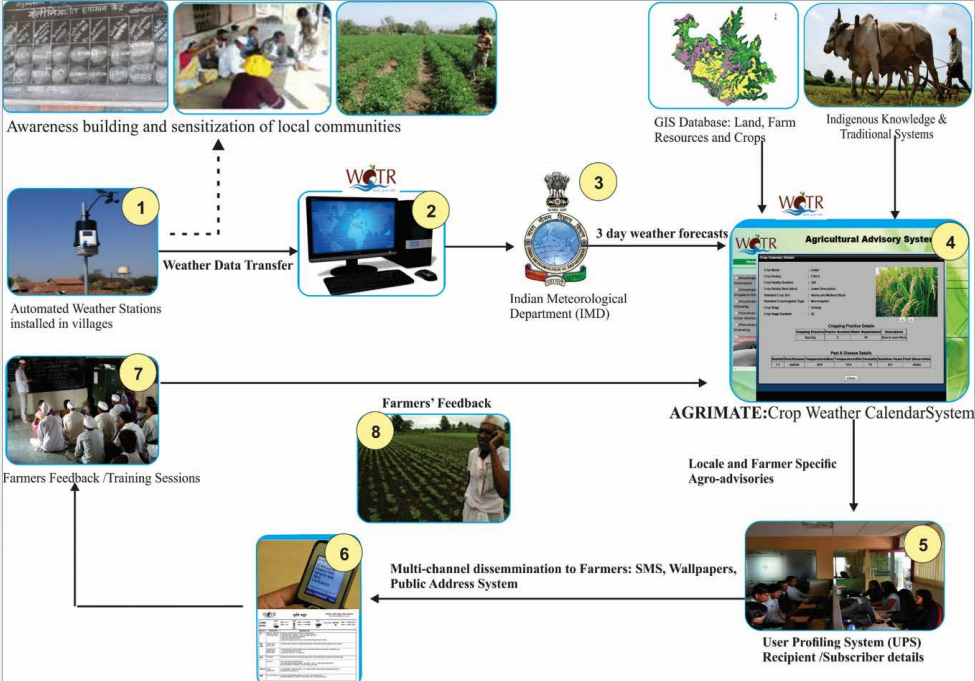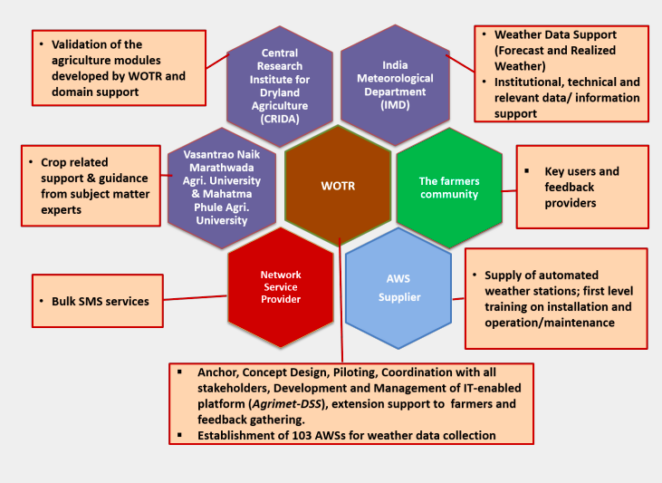Agro-met services and farmer responsiveness to advisories: Implications for climate smart agriculture

Context
Agro-met services delivered through SMS by the Watershed Organization Trust (WOTR) provide crop and locale-specific agroadvisories based on weather forecasts and the particular crop growth stage in order to reduce risks and improve agriculture productivity despite local climatic variations.
The objective of this *book chapter is to understand the nature and importance of different components of the WOTR advisory system and how farmers have responded to the agro-met advisory services.
Agricultural advisory services are defined by Birner et al. (2009) as “the entire set of organizations that support and facilitate people engaged in agricultural production to solve problems and to obtain information, skills, and technologies to improve their livelihoods and well-being.”
*Download the full chapter from the right-hand column. A summary of the key findings is provided below.
Approach

The integrated agro-meteorology service evolved by WOTR consists of four interlinked components:
- Weather awareness, local weather data acquisition, and short range weather forecasts;
- Crafting of agro-advisories, dissemination, and feedback gathering;
- An automated content management system (ACMS) for agro-meteorological advisory generation and dissemination; and
- On-site capacity building, knowledge and technology transfer and engagement with local institutions (Lobo et al, 2017).
WOTR, in collaboration with the India Meteorological Department (IMD), has installed 103 Automated Weather Stations (AWS) in the districts of Maharashtra. Altogether, they make for a high density grid ranging from 3-5 km between the weather stations, the reason being to provide a sufficiently dense network of high quality data points to enable the IMD to better calibrate their weather models, given the diversity of topographies and agroclimatic-ecologies obtaining in the project districts. Of these, 92 AWSs are telemetrically linked to WOTR’s servers and send on an hourly basis, weather information round-the-clock. This data is subject to quality control at WOTR and then forwarded to the IMD. IMD sends WOTR daily, three-day weather forecasts for respective villages.
Based on these short-term (3-day) local weather forecasts, agricultural experts from WOTR prepare agro-advisories with the help of crop weather calendars which have been prepared with inputs from the Central Research Institute for Dryland Agriculture (CRIDA) and two state agricultural universities (the Mahatma PhuleAgriculture University(MPKV) at Rahuri and the Vasantrao Naik Marathwada Agriculture University (VNMAU) at Parbhani) with whom WOTR has a knowledge-sharing collaboration. These advisories that are crop and locale-specific include integrated nutrient-water-pest-and diseases management recommendations that stress organic and environmentally sustainable interventions. These advisories are issued in the local language at least twice a week in the summer months and more frequently during the agricultural season, as required, thus alerting farmers and giving them enough time to implement suggested measures. The advisories are disseminated through SMSs to mobile phones, wallpapers that are put up at prominent places in the project villages and by word-of-mouth.
For more information on the components of the WOTR Advisory system and Interactions between key actors see page 4 of the full text.
Key Messages
- Setting up an advisory system that is location specific and responsive to individual famers needs involves interactions between diverse actors (farmers, NGOs, Research institutions, Government institutions, private organizations). One of the key factors for developing such a system is willingness of these diverse institutions to collaborate and bring together their respective strengths.
- Even though formal contracts provide a framework for working together, it is also important to develop trust and accountability among the different actors for smooth delivery of services as well as the ability to innovate and respond to changes on the ground.
- The delivery of advisory services also requires certain amount of resources to improve capacities, especially those of advisors (both subject matter specialists and local para-agronomists), who directly engage with the farmers and thus form the critical link in the advisory system.
- In the context of uptake/ follow up of advisories by the farmers, there were differences depending on the type of crop grown (see figure 2 below). In general, farmers follow advisories in case of high value crops (e.g. onion) as compared to staple food crops (e.g. pearl millet) for application of Diammonium phosphate (DAP) and complex fertilizers, micronutrients, pesticides, weedicides. Weather advisories had good uptake irrespective of type of crop.
- Some crop advisories received greater positive responses in terms of adoption as compared to others such. Weather advisories, FYM application, urea application, harvesting recieved the most uptake from both onion and pearl millet farmers (see figure 2 below).
- To make an advisory system demand driven and effective, the advisories need to address farmers’ requirements and be tailored to farm-specific conditions, including the farmers’ resources and constraints and the crops grown. They must also use high quality observed weather data and high resolution weather forecasts.

Going Forward
- Where there is poor or no mobile connectivity, then public address systems, wallpapers, advisory bulletins, Interactive Voice Response System (IVRS), telephone calls to local contact persons can be deployed.
- Where there is good mobile telephone connectivity, SMSs as well as IVRS can be used.
- Where there is good data/internet connectivity and smart phones can be used (3G and above), Apps which allow the farmers to provide inputs can be developed to deliver customised farm specific advisories.
Suggested citation
Bendapudi, R., Kumbhar, N., Gaikwad, P. and Lobo, C. (2019) Agro-Met Services and Farmer Responsiveness to Advisories: Implications for Climate Smart Agriculture. In: Handbook of Climate Change Resilience, Filho, W.L. (ed.). Earth and Environmental Science E-Book. Springer Nature. DOI: https://doi.org/10.1007/978-3-319-71025-9
(0) Comments
There is no content